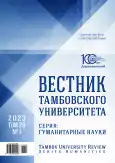Indicators of land conflict in the analysis of the peasant identity of the period of agrarian transformations of 1917–1920
- 作者: Gatilow E.E.1, Nikolashin V.P.2
-
隶属关系:
- Lipetsk State Technical University
- Derzhavin Tambov State University
- 期: 卷 28, 编号 1 (2023)
- 页面: 191-207
- 栏目: NATIONAL HISTORY
- URL: https://ogarev-online.ru/1810-0201/article/view/297912
- DOI: https://doi.org/10.20310/1810-0201-2023-28-1-191-207
- ID: 297912
如何引用文章
全文:
详细
The study of social behavior in history is closely related to the concepts of mentality and social identity. Being a real factor in the historical process, mentality manifests itself in the activities of large social groups, acts as a psychological justification for life strategies for survival. At the same time, mentality itself carries the character of a strategy, which does not explain the tactical – behavioral – reactions of a particular social group to crisis moments of existence, such as epidemics, wars, hunger strikes, etc. The specification of mental manifestations led to the use of the “tactical” category of social identity. Researchers emphasize the complex semantic context of this category. The author’s understanding is tied to social specifics – to peasant identity. The latter is defined as the approval of the survival strategy used in a given social group, which is practically implemented in a certain set of repetitive behavioral reactions, a behavioral pattern. The purpose of this study is to study the peasant identity of a particular region – the Chernozem region – during the period of agrarian transformations of 1917–1920. The article considers the structure of peasant identity, the behavioral reactions of the peasantry to changing economic conditions, and gives a classification of land conflicts. The article also presents the indicator possibilities of land conflicts and determines the place of peasant identity in the behavioral pattern of the black earth peasantry. The presented methodology for indicating land conflicts to determine the state of peasant identity in 1917–1920. Can be applied in the analysis of other historical periods. The study was conducted on the materials of the archives of the Lipetsk, Voronezh, Kursk, Oryol and Tambov regions.
作者简介
E. Gatilow
Lipetsk State Technical University
Email: gatilow.e@yandex.ru
ORCID iD: 0000-0002-4234-4333
Cand. Sci. (History), Associate Professor of History and Theory of State and Law Department
30 Moskovskaya St., Lipetsk, 398042, Russian FederationV. Nikolashin
Derzhavin Tambov State University
编辑信件的主要联系方式.
Email: nikolashin.vadim@yandex.ru
ORCID iD: 0000-0002-3595-8556
Dr. Sci. (History), Associate Professor of History and Philosophy Department
33 Internatsionalnaya St., Tambov, 392000, Russian Federation参考
- Gatilov E.V. (2020). Peasant identity as a factor in the study of social transformations in the late 19th – early 20th century. Istoriya: fakty i simvoly = History: Facts and Symbols, no. 3 (24), pp. 17-30. (In Russ.) https://doi.org/10.24888/2410-4205-2020-24-3-17-30, https://elibrary.ru/hhwvlx
- Shcherbakova I. (2004). «Identika» v rossiiskoi sotsiologii [“Identification” in Russian sociology]. In: Oberemko O.A., Ozhigova L.N. (eds.). Materialy Vserossiiskogo nauchno-metodicheskogo seminara «Sotsial’naya iden-tichnost’: sposoby kontseptualizatsii i izmereniya» [Proceedings of the All-Russian Scientific and Methodologi-cal Seminar “Social Identity: Ways of Conceptualization and Measurement”]. Krasnodar, Kuban State University, pp. 46-62. (In Russ.) Available at: https://www.isras.ru/files/File/Publica-tion/Novye_publikazii/Soc_ident_Oberemko_2004.pdf
- Solovev V.Yu. (2010). Osobennosti mirovozzreniya i khozyaistvennyi uklad russkikh krest’yan v porefor-mennyi period XIX – nachala XX v. (na materialakh gubernii Povolzh’ya) [Features of the worldview and economic structure of Russian peasants in the post-reform period of the 19th – early 20th century (based on the materials of the governorates of the Volga region)]. In: Esikov S.A. (executive ed.). Sbornik trudov uchastnikov nauchnoi konferentsii «Rossiiskii krest’yanin v gody voin i v mirnye gody (XVIII–XX vv.)» [Collection of works of participants of the scientific conference “The Russian peasant in the years of wars and in peaceful years (18th – 20th century)”]. Tambov, Tambov State Technical University Publ., pp. 15-22. (In Russ.) Available at: https://tstu.ru/book/elib/pdf/2010/kuznecova-a.pdf
- Shanin T. (2019). Neudobnyi klass: politicheskaya sotsiologiya krest’yanstva v razvivayushchemsya obsh-chestve: Rossiya, 1910–1925 [The Awkward Class: Political Sociology Peasantry in Developing Society. Russia 1910–1925]. Moscow, Delo Publ., 408 p. https://elibrary.ru/rffubp
- Tereshchenko A.A. (2011). Development of industry in the cities of the Central Chernozem region in the second half of the XIX – early XX century. Uchenye zapiski. Elektronnyj nauchnyj zhurnal Kurskogo gosu-darstvennogo universiteta = Scientific Notes. Electronic Scientific Journal of Kursk State University, no. 3-2 (19), pp. 103-124. (In Russ.) https://elibrary.ru/onmwcv
- Gatilov E.V., Nikolashin V.P. (2019). Land conflicts of black earth of the initial Soviet period 1917–1920. Klio = Klio, no. 12 (156), pp. 106-123. (In Russ.) https://elibrary.ru/ayvlea
- Gatilov E.V., Nikolashin V.P. (2021). Sources on problematics of land conflict in the Chernozem village: 1917–1920. Vestnik arhivista = Herald of an Archivist, no. 4, pp. 1039-1050. (In Russ.) https://doi.org/10.28995/2073-0101-2021-4-1039-1050, https://elibrary.ru/jwkeyb
- Malyazyov V.E. (2012). The peasant farmstead in the Russian countryside in the 1970s–1980s. Izvestiya PGPU im V.G. Belinskogo = Proceedings of Penza State Pedagogical University named after V.G. Belinsky, no. 27, pp. 810-814. (In Russ.) https://elibrary.ru/pkbdwn
- Gorodnova L.E. (2010). The semantic continuum of the concept of “estate”. Analitika kul’turologii [Analytics of Cultural Studies], no. 2 (17), pp. 183-190. (In Russ.) https://elibrary.ru/qzbhgj
补充文件









